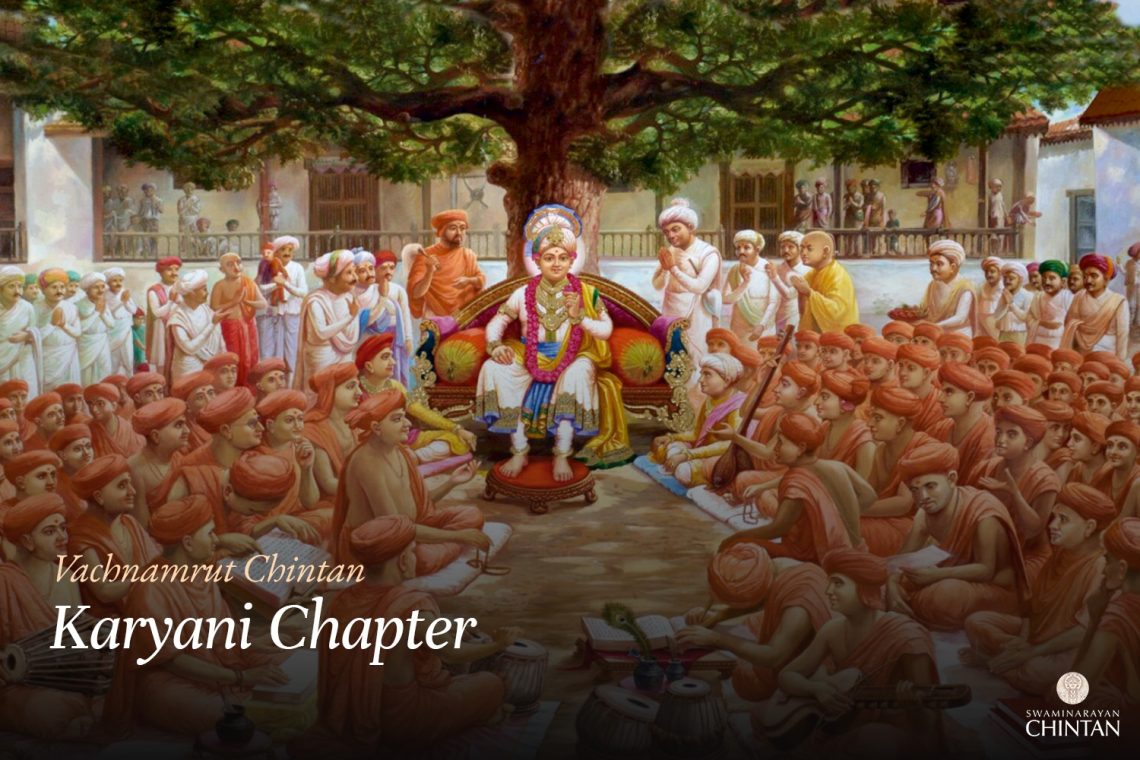Central Insights:
- The Sagun (possessing attributes) and Nirgun (free from attributes) nature of Bhagwan (God).
Main Points:
- Sagun and Nirgun are the divine powers of Bhagwan.
- The human form of Maharaj, who is Sachchidanand (eternal truth, consciousness, and bliss), is the original form of Bhagwan.
- One who understands the Sagun and Nirgun aspects of Bhagwan properly is not bound by Kal (time), Karma (actions), or Maya (illusion).
Commentary:
This Vachanamrut focuses on the Sagun and Nirgun aspects of God. Here, Muktanand Swami asked, “O Maharaj! The Shastras (scriptures) describe both the Sagun and Nirgun forms of Bhagwan. अणोरणीयान् महतो महीयान्निति — aṇoraṇīyān mahato mahīyān niti (Kathopanishad 3.1.2.20) How should we understand both these forms? By understanding them, how does it benefit a devotee? Because something that is subtle cannot be large, and something that is large cannot be subtle. So how can both exist within one form of Maharaj? And what benefit does a devotee gain by understanding this?”
Maharaj answered, “In reality, there are not two separate forms of Bhagwan – Sagun and Nirgun. The form of Bhagwan is eternally the same, but His grandeur manifests in two ways: Sagun grandeur and Nirgun grandeur. It is not that the form of Bhagwan or His Murti (image) has two separate forms—one Sagun and one Nirgun.”
Based on the entire Vachanamrut and in this particular discourse as well, Maharaj has referred to the form of Bhagwan and His Murti interchangeably. Thus, how can the concept of ‘Anoraniyan Mahato Mahiyan’—something being subtler than the subtlest and larger than the largest—apply to a single Murti? Or, what is the Shastra’s (scripture’s) intention in describing Bhagwan’s Murti in this manner?
In response, Maharaj says that the form of Bhagwan, or His Murti, is eternal and always the same. It does not become small like an atom one moment and large like a mountain the next. It is always one divine, youthful, Sachchidanand form—radiant, pure, and unchanging. It does not shift or change constantly. It is eternal, one form. So then, what causes it to appear different at times? That is due to Bhagwan’s divine and supernatural power, His grandeur. We can divide this grandeur into two categories: Sagun and Nirgun. The power within Bhagwan’s form or Murti is such that He can display His form as large as a mountain, or even as vast as the entire Brahmand (universe), or greater than many Brahmands. Just as Shri Krishna Bhagwan revealed His Vishwarup (universal form) to Arjun, and showed His Virat form to Duryodhan in the Kaurava assembly, or as Vaman Bhagwan revealed His Virat form to King Bali. This Virat form is also a source of wonder for us.
Maharaj’s power is even greater than what can be displayed, but can the Jeev (soul) bear it? That is why, in the Gita, when Bhagwan showed His Virat (universal) form, He told Arjun, दिव्यं ददामि ते चक्षुः पश्य मे योगमैैश्वरम् — divyam dadāmi te cakṣuḥ paśya me yogam aiśvaram (Gita 11:8). What matters is how much we, as souls, can handle and understand. There is no limit to what exists within Bhagwan’s Murti (form). Even during the chapter on samadhi, Maharaj revealed many such grand forms of His Murti. This is why the forms of Bhagwan that reveal His grandeur are called Sagun forms or Sagun grandeur. Here, Sagun refers to the state of demonstrating physicality or manifest qualities. However, it is not that Bhagwan can only show physicality in His Murti. Bhagwan’s divine power is such that He can also reveal the most subtle aspects of Himself.
All objects of the world are material, and subtler than them is the soul. The soul pervades everything, and as its purity increases, it becomes more refined and attains a subtler state. When it reaches the pure state of Akshar (eternal, indestructible entity), it reaches its limit. But Bhagwan is subtler than that, capable of pervading even within Akshar and purifying it as well. Bhagwan does not need to abandon His original form to assume a subtler form to pervade up to the level of Akshar. The question of how the infinite can exist within the finite—how the Virat (universal) can fit into an atom—arises. Shouldn’t Bhagwan, at the very least, become smaller or subtler to enter within? But this question pertains to our limited intellect, not to the nature of Bhagwan’s form.
In the past, certain aspects of modern science or new discoveries were not accepted or understood by people of those times, even if they were educated or intelligent. However, today, even an uneducated person can comprehend and accept them. Thus, the issue is not one of reality, but of what can be grasped by our intellect. The Shastras (scriptures) state that Bhagwan’s form, although only three and a half hands in size, can pervade all spaces and enter all things. It is not composed of material elements like our bodies. Bhagwan does not depend on Kal (time), space (Kshetra), or material substance. His power is supernatural and divine. If this divine power is understood by our intellect, then it is not difficult to comprehend. Bhagwan can pervade even the most subtle form of Aksharbrahm (the eternal and indestructible form of Brahm) with His Murti.
Nowadays, scientists have made discoveries in genetic cells where they can predict a child’s characteristics—such as skin color, hair, features, intelligence, and temperament—while the child is still in the mother’s womb. If they detect a defect, such as in one eye, they can reverse a cell from another part of the body, reset it to a neutral state, and then forward it to fix the eye to make it perfect, or they can create a clone. Through their spiritual powers, Yogis can increase the size of their bodies. For instance, Hanuman expanded His body to the size of a mountain, as mentioned in the Ramayan. So, if Bhagwan (God) wishes, can He not do the same with His body? He certainly can, if He is Bhagwan. Whether He does it or not is a matter of His own will. That is why Maharaj says that the form of Shreeji Maharaj that you see in front of you is the original form, and His Sagun and Nirgun aspects are His divine grandeur. Bhagwan is the ‘Yogakalana Puran Dariya’—the ocean of all yogic powers. He is the Yogeshwar (Lord of all yogis). His Murti (form) lacks no kind of divine grandeur. Maharaj has explained these two types of grandeur through examples from the life of Shri Krishna Bhagwan.
We revere Maharaj’s Murti with even more glory because this form embodies that grandeur. This is the original form. All other forms are based on this one. Bhagwan manifests His grandeur from within Himself through His independent will. Maharaj says that understanding both the Nirgun and Sagun aspects of Bhagwan’s Murti means that Kal (time), Karma (actions), and Maya (illusion) will no longer bind such a devotee. Such a devotee experiences constant wonder in their heart all day long.
Here, a question may arise: “Even though we believe in Bhagwan as He describes Himself, why do we not experience the fruits of that belief?” The answer is that while we intellectually understand the Sagun and Nirgun aspects of Bhagwan’s Murti, we are not able to fully internalize that understanding at the level of our soul. If we were truly able to internalize it, the fruits Maharaj described would certainly appear in our hearts. However, we do not experience any such wonder in Bhagwan’s Murti, which is why we do not see those results either.
Glossary
| Sagun – Possessing attributes |
| Nirgun – Beyond the three qualities of Maya |
| Murti – Divine form of God Refers to Bhagwan’s physical or imagined divine form, which provides joy and spiritual connection during contemplation. |
| Kal – Time The influence of the time period or era on a person’s tendencies and inclinations. |
| Karma – Action The deeds performed by a Jeev, which determine its future experiences based on the law of cause and effect. |
| Maya – Illusion The material energy that entangles the Jeev in worldly existence and distracts from Bhagwan. |
| Vishwarup – Universal form |
| Virat Form – Expansive divine form |
| Aksharbrahm – The eternal and unchanging divine realm The supreme divine existence or state that is beyond the material world, often referenced in Swaminarayan philosophy. |
| Sachchidanand – Existence, Consciousness, and Bliss |
| Brahmand – Universe |
| Antaryami Shakti – All-pervasive power |
| Yogeshwar – Master of all yogic powers |
| Aishwarya – Divine grandeur |

